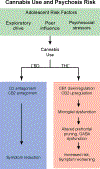Adolescent Neurodevelopment and Vulnerability to Psychosis
- PMID: 32896384
- PMCID: PMC9397132
- DOI: 10.1016/j.biopsych.2020.06.028
Adolescent Neurodevelopment and Vulnerability to Psychosis
Abstract
Adolescence is characterized by significant changes in several domains, including brain structure and function, puberty, and social and environmental factors. Some of these changes serve to increase the likelihood of psychosis onset during this period, while others may buffer this risk. This review characterizes our current knowledge regarding the unique aspects of adolescence that may serve as risk factors for schizophrenia spectrum disorders. In addition, we provide potential future directions for research into adolescent-specific developmental mechanisms that impart vulnerability to psychosis and the possibility of interventions that capitalize on adolescents' unique characteristics. Specifically, we explore the ways in which gray and white matter develop throughout adolescence in typically developing youth as well as in those with psychosis spectrum disorders. We also discuss current views on the function that social support and demands, as well as role expectations, play in risk for psychosis. We further highlight the importance of considering biological factors such as puberty and hormonal changes as areas of unique vulnerability for adolescents. Finally, we discuss cannabis use as a factor that may have a unique impact during adolescent neurodevelopment, and subsequently potentially impact psychosis onset. Throughout, we include discussion of resilience factors that may provide unique opportunities for intervention during this dynamic life stage.
Keywords: Adolescence; Cannabis; Development; Psychosis; Schizophrenia; Social function.
Copyright © 2020 Society of Biological Psychiatry. Published by Elsevier Inc. All rights reserved.
Conflict of interest statement
Disclosures
All authors report no biomedical financial interests or potential conflicts of interest.
Figures


References
-
- Lebel C, Walker L, Leemans A, Phillips L, Beaulieu C (2008): Microstructural maturation of the human brain from childhood to adulthood. Neuroimage. 40:1044–1055. - PubMed
-
- Blakemore SJ, Mills KL (2014): Is adolescence a sensitive period for sociocultural processing? Annu Rev Psychol. 65:187–207. - PubMed
Publication types
MeSH terms
Grants and funding
LinkOut - more resources
Full Text Sources
Other Literature Sources
Medical

